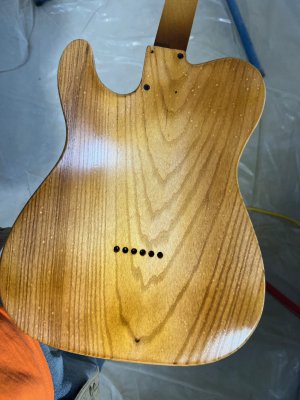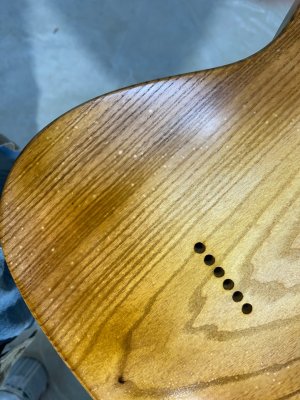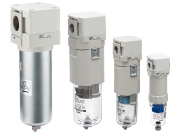Ralph
Newbie
- Messages
- 6
Help,
I am in the process of finishing my first guitar. This is a one piece ash body from Warmoth. It seemed to me that things were progressing well until I started getting some orange peel.
I sanded the orange peel out and moved on - had a few other problems but was making progress and the guitar was looking ok for a first time.
Then I got the spots in the attached photos! What a mess. The dots seem to be present in test sprays on scrap wood also so not something on the guitar??
Here is a list of my steps and materials used:
Spray rig Fuji Q5 Platinum with 0.08 air cap, needle and nozzle. Temperature 70ºF, humidity 45%
Any thoughts about what to do to fix this??



I am in the process of finishing my first guitar. This is a one piece ash body from Warmoth. It seemed to me that things were progressing well until I started getting some orange peel.
I sanded the orange peel out and moved on - had a few other problems but was making progress and the guitar was looking ok for a first time.
Then I got the spots in the attached photos! What a mess. The dots seem to be present in test sprays on scrap wood also so not something on the guitar??
Here is a list of my steps and materials used:
- One piece ash body from Warmoth
- Sanded with 220 and 320 Frecut gold
- Sprayed 2 coats of Target EM 1000 reduced 50% with distilled water***
- Pore filled with Colortone water based Ash filler
- Sealed with 2 more coats of EM 1000
- Light sanding with Frecut gold 320p
- 2 coats of EM 1000 thinned about 15% with distilled water tinted with Colortone Vintage Amber
- 1 coat of the above with 6 drops of Colortone medium brown added
- Got some orange peel - sanded and recoated with above vintage amber / medium brown
- Sprayed a coat of EM1000 with color tone medium brown and got the dots.
Spray rig Fuji Q5 Platinum with 0.08 air cap, needle and nozzle. Temperature 70ºF, humidity 45%
Any thoughts about what to do to fix this??








